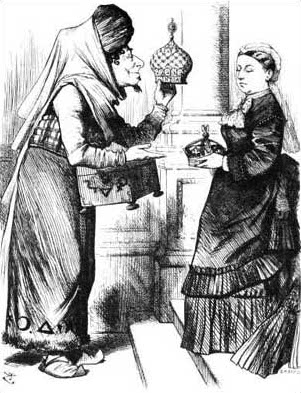 |
| Hughendon Manor on a beautiful summer day! |
On the way back from Easter break I visited Hughendon Manor which is now ran by the National Trust. This was the house of Benjamin Disraeli who was English Prime Minister in 1868 and from 1874-1880 and famously Queen Victoria's good friend and William Gladstone's fierce opposition.
The house was originally Georgian but Disraeli restyled it to this beautiful Neo-Gothic manor, removing the cladding on the exterior and decorating the inside with Tudor-esque plasterwork ceilings, wood panelling and flocked wallpaper. I really like this style of design and so found this very enjoyable to visit.
There was a really interesting video documentary in one room about Disraeli's life. Because of his Jewish heritage, throughout his career he came across many obstacles by anti-Semitic critics. In contemporary caricatures by publications such as Punch he was often depicted as the untrustworthy, exotic foreigner, for example in the cartoon above titled 'New Crowns for Old'
There was a really interesting video documentary in one room about Disraeli's life. Because of his Jewish heritage, throughout his career he came across many obstacles by anti-Semitic critics. In contemporary caricatures by publications such as Punch he was often depicted as the untrustworthy, exotic foreigner, for example in the cartoon above titled 'New Crowns for Old'
My main purpose of this visit was to see the robes that were on display in the house. I have been researching on the National Trust Collections online archive and came across these articles which I thought it would be interesting to see.
This robe is for the Chancellor of the Exchequer, which Disraeli was in 1852, 1858 and 1866. A Chancellor is a person elected in cabinet who is in charge of the economy in Britain. Today
There is a wealth of portraits on Chancellor's robes in comparison to Mayors. This is probably because they had/have such a central position in politics throughout history and so have been documented whereas Mayors are a regional position.
This robe was made for Disraeli when he was made Earl Beaconsfield in 1876 and elevated to the House of Lords by Queen Victoria. As I have learnt before about peerage robes you can tell this is a robe of an Earl because of the number of ermine bars. It is the same as with coronation gowns, where the number of rowns of sealskin spots denote the rank of the peer: 4 for a Duke, 3 1/2 for a Marquess, 3 for an Earl, 2 1/2 for a Viscount and 2 for a Baron.
"The peers' parliamentary robe was introduced during the 15th century and has changed very little since then. It is a full length robe of finely woven scarlet wool with a collar and edging of white miniver fur, and is worn over a mourning suit. The side seams of the robe are open and the different degrees of the peerage are indicated by the number of miniver bars, which extend from the right front edge of the robe to the side seam and form the side seam round to the centre back. Each bar of miniver is three inches wide and is edged with a two-inch band of gold lace." (Campbell, U 1989)
It was quite hard to see the detailing of the robes because of the exhibition environment it was in. Understandably it was in a case and the room was curtained to preserve the textiles but it was a shame that this dimness did not show off the garments to their full potential. The Chancellors robe in particular is made with gold thread and sequin bits, the purpose being to show the rank and wealth of the garment when the embellishments shimmered in the light.
There is a wealth of portraits on Chancellor's robes in comparison to Mayors. This is probably because they had/have such a central position in politics throughout history and so have been documented whereas Mayors are a regional position.
This robe was made for Disraeli when he was made Earl Beaconsfield in 1876 and elevated to the House of Lords by Queen Victoria. As I have learnt before about peerage robes you can tell this is a robe of an Earl because of the number of ermine bars. It is the same as with coronation gowns, where the number of rowns of sealskin spots denote the rank of the peer: 4 for a Duke, 3 1/2 for a Marquess, 3 for an Earl, 2 1/2 for a Viscount and 2 for a Baron.
| Portrait of Lord John Singleton Copley wearing Baron's robes on display in the house |
"The peers' parliamentary robe was introduced during the 15th century and has changed very little since then. It is a full length robe of finely woven scarlet wool with a collar and edging of white miniver fur, and is worn over a mourning suit. The side seams of the robe are open and the different degrees of the peerage are indicated by the number of miniver bars, which extend from the right front edge of the robe to the side seam and form the side seam round to the centre back. Each bar of miniver is three inches wide and is edged with a two-inch band of gold lace." (Campbell, U 1989)
It was quite hard to see the detailing of the robes because of the exhibition environment it was in. Understandably it was in a case and the room was curtained to preserve the textiles but it was a shame that this dimness did not show off the garments to their full potential. The Chancellors robe in particular is made with gold thread and sequin bits, the purpose being to show the rank and wealth of the garment when the embellishments shimmered in the light.





No comments:
Post a Comment